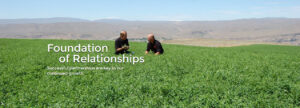Feeding Higher Forage Diets before Calving Improves Dairy Cow Metabolic Health
Dairy cows are frequently afflicted with metabolic diseases after calving. The high incidence of disease is thought to be related to the prolonged periods of negative energy balance that commonly occur postpartum. The dietary energy requirements of dairy cows are at their highest levels at calving and immediately postpartum and in most cases, a cow cannot physically eat enough feed to meet her energy needs. For an unknown reason, this period is also characterized by a drop in dry matter intake. Therefore, during this time, the cow is in a state of negative energy balance (NEB).

In an effort to reduce NEB, many dairy producers will feed cows an energy dense diet beginning three weeks before calving. However, this practice may lead to overconsumption of energy, which is subsequently stored as triglycerides (fat stores) in adipose tissue. During times of NEB, triglycerides are broken down into non-esterified fatty acids (NEFA) that are used for energy. NEFA are transported in the blood to the liver where they are transformed into ketone bodies. Beta hydroxybutyrate (BHB) is the most common ketone body in dairy cows. While BHB is a highly available energy source, excess levels can lead to subclinical or clinical ketosis. Subclinical ketosis can decrease milk production and affect reproductive performance. In addition, surplus NEFA are repackaged into triglycerides in the liver, which accumulate, and thus, increase the risk of fatty liver. Metritis, retained fetal membranes, mastitis, milk fever, and displaced abomasum have been associated with fatty liver syndrome in dairy cows. Interestingly enough, cows that consume excess energy and are over-conditioned prior to calving tend to experience more extreme NEB postpartum and have higher concentrations of BHB than cows that were fed prepartum diets that met energy requirements.
A group of researchers from the University of British Columbia and Agriculture and Agri-Food Canada recently reported that feeding a high forage diet that is low in energy in the 3 weeks before calving decreased the incidence of subclinical ketosis in dairy cows. Sixty days before calving, 91 Holstein cows were dried off and fed a diet that contained 87% forage (alfalfa hay, grass silage, ryegrass straw, corn silage). Three weeks prior to expected calving, half of the cows were switched to a 77% forage diet (alfalfa hay, corn silage) while the other half remained on the 87% forage diet. After calving, all cows were fed the same lactation diet. Cows fed the 87% forage diet consumed about 18% less dry matter in the 3-week prepartum period than cows fed the 77% forage diet. In other words, cows fed the 87% forage diet consumed 112% of NRC recommendations for net energy of lactation (NEL), while cows fed the 77% forage diet ate 130% of NRC recommendation for NEL. There were no differences in dry matter intake between groups after calving. Daily blood samples were also collected from all cows for 10 days following calving and levels of BHB were determined. Subclinical ketosis was diagnosed when BHB concentrations exceeded a predetermined threshold. Cows fed the 87% forage diet had lower blood BHB levels and only 17% were diagnosed with subclinical ketosis. In comparison, 49% of cows fed the 77% forage diet had subclinical ketosis.
In summary, a high forage diet to dairy cows during the dry period effectively controls energy intake. This practice helps to reduce the incidence of subclinical ketosis after calving. A slight improvement in conception rate was also noted when cows were fed a high forage diet before calving. More studies are needed to determine the long-term effect of feeding low energy diets during the dry period on subsequent reproductive performance in dairy cows.
To receive this blog from Anderson Hay directly in your email, subscribe above on the right.
Reference
Vickers, L.A., D.M. Weary, D.M. Veira, and M.A.G. von Keyserlingk. Feeding a higher forage diet prepartum decreases incidences of subclinical ketosis in transition dairy cows. J Anim Sci. 2012 Dec 10. [Epub ahead of print].


